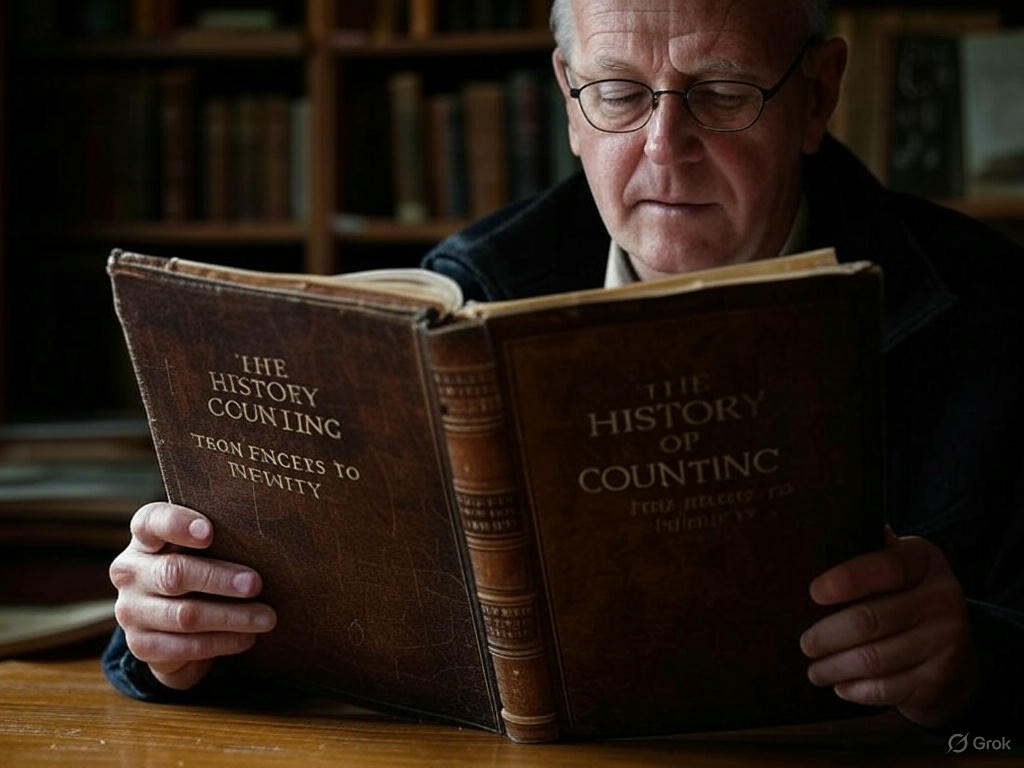A Journey Through Numerical Evolution
Introduction
When was the last time you counted something? Perhaps you tallied expenses, measured ingredients for a recipe, or simply checked the time. Counting is so embedded in our daily lives that we rarely pause to consider its profound historical journey. Yet this seemingly simple concept—the ability to quantify our world—represents one of humanity’s most transformative intellectual achievements. The story of how we progressed from counting on our fingers to contemplating the concept of infinity isn’t just a mathematical tale; it’s a deeply human narrative about problem-solving, cultural exchange, and our relentless drive to understand the universe.
As someone who’s spent years studying the anthropological foundations of mathematical thinking, I’ve come to appreciate how counting systems reveal as much about human psychology and cultural values as they do about mathematical progress. In this comprehensive exploration, we’ll trace the remarkable evolution of counting across civilizations and millennia, uncovering how these numerical innovations fundamentally shaped human history and continue to influence our world today.
Table of Contents
- The Dawn of Counting: Prehistoric Beginnings
- Early Civilization Number Systems
- The Revolutionary Concept of Zero
- Place Value: The Idea That Changed Everything
- Counting in Different Bases
- The Birth of Modern Numerals
- Beyond the Countable: Infinity and Abstract Numbers
- How Counting Transformed Trade, Science, and Technology
- Counting Curiosities from Around the World
- The Future of Numbers: Digital Age and Beyond
The Dawn of Counting: Prehistoric Beginnings
Our First Counting Tools: The Human Body
The earliest “counting device” was undoubtedly the human body itself. Archaeological and anthropological evidence suggests that finger counting predates any written numerical system—a practice so intuitive that it evolved independently across cultures worldwide. The very word “digit” reveals this connection, coming from the Latin “digitus” meaning finger or toe.
This connection between fingers and numbers explains why base-10 systems became predominant globally. Yet some cultures took different paths: the Yuki people of California used a base-8 system based on counting spaces between fingers rather than the fingers themselves, while various Papua New Guinea tribes developed base-2 counting systems focusing on pairs.
Beyond Fingers: The First Physical Records
As human needs evolved beyond what fingers could track, physical recording methods emerged. The Ishango bone, discovered in Central Africa and dating to approximately 20,000 BCE, features a series of notches that many scholars interpret as an early tally system. Similarly, the Lebombo bone from southern Africa (35,000 BCE) contains 29 notches, possibly tracking lunar cycles.
I’ve held replicas of these ancient artifacts, and what strikes me most is how they represent not just counting but humanity’s first attempts to extend our mental capacity through external tools—essentially the world’s first information technology.
From Concrete to Abstract: The Cognitive Leap
The transition from tallying specific items (three goats, four fish) to understanding numbers as abstract concepts (the number “three” itself) represents one of the most significant cognitive advances in human evolution. This conceptual shift—which developmental psychologists have observed children still making today—allowed for more sophisticated mathematical thinking.
Evidence suggests this abstraction emerged unevenly, with some hunter-gatherer societies developing only limited number words while agricultural communities rapidly expanded their numerical vocabularies as trading needs grew more complex.
Early Civilization Number Systems
Mesopotamia: The Birth of Written Numbers
Around 3400 BCE, the Sumerians in Mesopotamia (modern-day Iraq) developed one of the earliest written number systems as part of their cuneiform script. Initially pictographic—with symbols directly representing quantities of objects—their system evolved into more abstract representations.
The Sumerian system introduced the first partial place-value system, using different symbols for 1, 10, 60, 600, and so on. This sexagesimal (base-60) system might seem strange today, but its legacy persists in our 60-minute hours and 360-degree circles.
Egyptian Hieroglyphic Numerals: Beautiful but Cumbersome
The ancient Egyptians developed a decimal (base-10) system around 3000 BCE, using unique hieroglyphic symbols for powers of ten:
- A vertical stroke (|) for 1
- A heel bone (⌒) for 10
- A coiled rope (Ꝏ) for 100
- A lotus flower (⧓) for 1,000
- A pointing finger for 10,000
- A tadpole for 100,000
- An astonished man for 1,000,000
While visually striking, this additive system required repetition of symbols (writing eight as ||||||||), making complex calculations unwieldy. Nevertheless, it served Egyptian administrators, architects, and astronomers for nearly 4,000 years.
Chinese Rod Numerals: Early Calculation Systems
In China, counting evolved through several systems dating back to at least 1200 BCE. Rod numerals used arrangements of bamboo sticks for calculation, implementing a decimal place value system. This allowed for sophisticated accounting and calculation methods, enabling complex infrastructure projects and administrative systems across the vast Chinese empire.
What’s particularly fascinating about the Chinese approach is how it optimized for calculation rather than just representation—an early recognition that how we write numbers affects how we can manipulate them.
The Revolutionary Concept of Zero
Zero’s Absence: Early Systems Without Nothing
Most early number systems lacked a concept of zero, which seems strange to us today. Egyptians, Romans, and early Greeks had no symbol for nothing. This created ambiguities in their mathematics—in the Roman numeral system, how would you distinguish between II (2) and II with a space meaning 2 and 0? This limitation made advanced mathematics cumbersome.
The Placeholder Zero: Babylonian Breakthroughs
The Babylonians made a crucial step around 700 BCE by introducing a placeholder symbol to represent an empty position in their sexagesimal system. While not yet a true “zero” that could be operated on, this innovation significantly improved their astronomical and commercial calculations.
The Birth of Zero as a Number: India’s Mathematical Gift
The concept of zero as a full-fledged number appears to have crystallized in India around the 5th century CE. Hindu mathematicians not only used zero as a placeholder but recognized it as a number with its own mathematical properties. The mathematician Brahmagupta wrote rules for arithmetic involving zero and negative numbers in his 628 CE work “Brahmasphutasiddhanta.”
I’ve always found it profound that understanding “nothing” as “something” represents one of humanity’s most sophisticated intellectual leaps. This philosophical dimension of zero—treating absence as a presence—reveals how deeply mathematical and philosophical thinking intertwine.
Place Value: The Idea That Changed Everything
The Limitations of Additive Systems
Early Roman numerals (I, II, III, IV, V, etc.) and Egyptian numerals operated on additive principles—the value of a number was simply the sum of the values of all its symbols. While straightforward, this approach made arithmetic operations laboriously complex. Try multiplying MCMLXIV by XLII in Roman numerals, and you’ll quickly appreciate the problem!
The Positional Revolution
Place value systems, where a symbol’s position determines its value, emerged independently in several cultures. The Babylonians, Chinese, and Mesoamerican Maya all developed positional notation, but the Indian decimal place value system that evolved between 100-500 CE proved most influential to our modern approach.
This system’s efficiency comes from needing only ten symbols (0-9) to represent any number, with each position representing a power of ten. The simplicity masks its profound power—with just these ten digits, we can represent everything from the microscopic scale of quantum physics to the vast distances between galaxies.
How Place Value Transformed Calculation
The adoption of place value dramatically simplified arithmetic operations. Addition, subtraction, multiplication, and division became accessible to merchants and traders, not just specialized mathematicians. This democratization of calculation capabilities had profound economic and social impacts, enabling more complex trade networks and financial systems.
Counting in Different Bases
Beyond Base 10: Biological and Cultural Influences
While decimal systems dominate today, human cultures have experimented with various number bases, often influenced by biological or practical factors:
- Base 2 (Binary): Used by some Pacific Island cultures and, of course, modern computers
- Base 5 (Quinary): Found in cultures that counted by hand (5 fingers)
- Base 12 (Duodecimal): Used in various measuring systems (feet, inches) due to 12’s many divisors
- Base 20 (Vigesimal): Used by Maya, Aztec, and traditional Celtic systems (counting fingers and toes)
- Base 60 (Sexagesimal): The Babylonian system that gives us 60 minutes and 60 seconds
Each system offers certain mathematical advantages and disadvantages. The Babylonian sexagesimal system, for instance, facilitates division as 60 has many factors (1, 2, 3, 4, 5, 6, 10, 12, 15, 20, 30).
The Fascinating Maya Vigesimal System
The Maya civilization developed a sophisticated base-20 counting system with a true zero, place value, and only three symbols (a dot for 1, a bar for 5, and a shell-like symbol for zero). With this elegant system, Mayan astronomers calculated celestial cycles with remarkable precision, predicting eclipses and planetary movements centuries in advance.
What makes the Maya system particularly impressive is its independent development of concepts like zero and place value, demonstrating how these powerful mathematical ideas emerged multiple times in human history when cultural needs demanded them.
The Birth of Modern Numerals
The Arabic-Indian Numerical Revolution
Our modern digits (0, 1, 2, 3, 4, 5, 6, 7, 8, 9) are often called “Arabic numerals,” though they originated in India around the 5th century CE. Arab mathematicians encountered this system during the 8th century and recognized its superiority for calculation and scientific work, subsequently spreading it westward.
Fibonacci and the European Adoption
In 1202, the Italian mathematician Fibonacci (Leonardo of Pisa) published “Liber Abaci” (Book of Calculation), which advocated for the adoption of the Arabic-Indian numeral system in Europe. Having learned these methods during his travels in North Africa, Fibonacci demonstrated their practical advantages for merchants, bankers, and scholars.
The transition wasn’t immediate—Roman numerals persisted in Europe for centuries in certain contexts—but the efficiency of the new system eventually proved irresistible. By the 15th century, these numerals were widely used throughout Europe, catalyzing the scientific and commercial revolutions that followed.
The Typography of Numbers
The shapes of our modern numerals evolved significantly over time. Early Indian forms bear little resemblance to our current digits, which emerged through centuries of handwritten evolution and, later, standardization through printing technologies. Regional variations persisted until relatively recently—the forms of 4, 5, and 7 still vary slightly between different countries and writing traditions.
I’ve always found it fascinating that the symbols we use daily for counting have their own evolutionary history, shaped by the materials people wrote with, cultural aesthetics, and the human tendency to simplify frequently-used symbols.
Beyond the Countable: Infinity and Abstract Numbers
Early Concepts of Infinity
The concept of infinity challenged mathematicians for millennia. Ancient Greek mathematicians like Zeno posed paradoxes involving infinite processes, while various philosophical traditions grappled with the concept of endlessness. Many cultures developed symbols or terms for “countless” or “immeasurable” quantities, but rigorous mathematical treatment remained elusive.
Irrational, Transcendental, and Imaginary Numbers
The discovery of numbers that couldn’t be expressed as fractions shocked ancient Greek mathematicians. The Pythagorean school reportedly kept the existence of irrational numbers (like √2) secret, as they threatened their philosophy that all phenomena could be expressed through whole number ratios.
Later mathematical developments introduced even more abstract numbers:
- Negative numbers (fully accepted in Europe only by the 17th century)
- Transcendental numbers like π and e
- Imaginary numbers based on the square root of -1
- Complex numbers combining real and imaginary components
Each extension of our number concept initially faced resistance but ultimately expanded human capability to model and understand the physical world.
Georg Cantor and Different Sizes of Infinity
In the late 19th century, German mathematician Georg Cantor revolutionized our understanding of infinity by proving that some infinities are larger than others. His diagonal argument demonstrated that the infinity of real numbers is larger than the infinity of counting numbers—a concept so radical that it provoked intense controversy among his contemporaries.
Cantor’s work opened entirely new mathematical realms and influenced fields ranging from computing to cosmology, showing how pure mathematical thinking about counting could lead to profound insights about the nature of reality itself.
How Counting Transformed Trade, Science, and Technology
From Counting to Accounting
The development of sophisticated counting systems enabled increasingly complex economic arrangements. Double-entry bookkeeping, developed in medieval Italy, revolutionized commerce by allowing merchants to track assets, liabilities, and capital with unprecedented accuracy. This innovation helped fuel the Renaissance by supporting the banking systems that financed art, architecture, and exploration.
Measurement, Science, and Mathematics
Counting systems provided the foundation for measurement, which in turn enabled scientific progress. From Eratosthenes measuring Earth’s circumference around 240 BCE to modern quantum physics counting subatomic particles, our ability to quantify observations has been central to scientific advancement.
The relationship works both ways—scientific needs often drove numerical innovations. Navigation required precise astronomical calculations, leading to improvements in trigonometry and logarithms. Today, quantum computing explores entirely new paradigms based on qubits rather than classical binary digits.
The Digital Revolution: Back to Binary
In a fascinating historical circle, modern computing has returned to one of the simplest counting systems—binary. The digital world reduces everything to sequences of 0s and 1s, demonstrating how a primitive base-2 system can, with sufficient complexity, represent and process all human knowledge.
This digital transformation has made counting more central to human existence than ever before, with billions of calculations occurring every second to power our information age.
Counting Curiosities from Around the World
Linguistic Number Patterns
Languages reveal fascinating patterns in how humans conceptualize numbers. Some Pacific languages use specific counting words for different types of objects (long things, round things, etc.). The Pirahã people of the Amazon reportedly have a “one-two-many” system with no specific words for larger quantities.
Even familiar languages show interesting patterns—English has unique words only up to “twelve” before switching to the “-teen” pattern, reflecting ancient duodecimal influences.
Body Counting Systems
Some Papua New Guinea cultures developed elaborate body counting systems, mapping numbers sequentially across body parts to track figures up to 60 or more. A trader might point to their right shoulder to indicate “22” in a commercial transaction.
Calculation Tools Through History
Physical calculation devices reveal human ingenuity across cultures:
- The abacus, used in various forms across Asia, the Middle East, and Europe
- Quipu, the Incan knot-based recording system that tracked not just quantities but categories and narratives
- Napier’s bones and slide rules that mechanized multiplication and division
- Mechanical calculators like the Pascaline (1642) and Leibniz’s Stepped Reckoner (1672)
Each technology extended human cognitive abilities, allowing more complex accounting, engineering, and scientific work.
The Future of Numbers: Digital Age and Beyond
Computation Beyond Human Scale
Today’s computational systems work with numbers far beyond human comprehension—processing billions of operations per second and handling datasets with trillions of data points. Modern cryptography relies on prime numbers so large they would take thousands of pages to write out in decimal form.
Quantum Computing: Beyond Binary
Quantum computing introduces qubits that exist in superpositions of states, potentially allowing certain calculations that would be practically impossible with classical computing. This represents perhaps the most significant evolution in counting technology since the adoption of the place-value system.
AI and Numerical Cognition
Artificial intelligence systems now develop their own representations of numerical concepts, sometimes arriving at novel approaches to calculation problems. As these systems evolve, we may witness new computational paradigms that extend beyond traditional human counting methods.
Practical Application: Appreciating Number Systems in Daily Life
Recognizing Numerical Heritage
Many of us use multiple number systems daily without realizing it:
- Decimal for most counting and math (base 10)
- Hours, minutes, and seconds (vestiges of Babylonian base 60)
- Binary in computing (base 2)
- Duodecimal for months of the year (base 12)
You can deepen your appreciation by:
- Noticing these different systems in your environment
- Trying simple calculations in different bases
- Exploring how children learn counting concepts
- Examining how different languages express numbers
Teaching Counting Across Cultures
For educators, incorporating diverse counting systems offers multiple benefits:
- It helps students understand that mathematical conventions are cultural constructions
- It demonstrates how different approaches can solve the same problems
- It connects mathematics to history, linguistics, and anthropology
- It can make numerical concepts more accessible to students who think differently
Try having students create their own counting system as an exercise—it builds deeper understanding of place value and numerical properties.
Mathematical Tourism
For the mathematically curious traveler, historical counting systems offer fascinating destinations:
- The Engineering Mathematics Museum in Dresden, Germany
- The Museum of the History of Science in Oxford, England
- The National Museum of Mathematics in New York
- The zero stone marker in Gwalior, India, with one of the earliest inscriptions of the symbol “0”
These sites provide tangible connections to the human story of counting.
Conclusion: The Unfinished Count
The history of counting reflects humanity’s remarkable intellectual journey—from concrete tallies scratched on bones to abstract concepts of transfinite numbers. Each innovation built upon previous developments while responding to practical needs, showing how mathematics emerges from the interplay of pure thought and real-world problem-solving.
As we continue into the digital age, our relationship with numbers evolves further. Algorithms make countless calculations on our behalf, often operating beyond human oversight or comprehension. Yet the fundamental concepts—the place value system, zero, and the abstractions that build upon them—remain the foundation of our quantitative understanding of the world.
The next time you count change, check the time, or ask your smartphone to calculate a tip, take a moment to appreciate the thousands of years of human ingenuity that make these simple acts possible. The history of counting isn’t just about mathematics—it’s about human creativity and our endless quest to make sense of our world, one number at a time.
FAQs About the History of Counting
When did humans first begin counting?
Archaeological evidence suggests counting predates writing, with tally marks appearing at least 40,000 years ago. The cognitive ability to enumerate small quantities may be even older and possibly innate, as studies show some animals have basic numerical abilities.
Why do most cultures use base-10 counting systems?
The predominance of base-10 systems likely stems from humans having ten fingers, making finger counting a natural and universal practice. However, some cultures developed different bases like the Babylonian base-60 or Mayan base-20 systems.
Who invented zero?
The concept of zero evolved gradually. Babylonians used a placeholder zero around 700 BCE, but the Indians developed zero as a true number with mathematical properties around the 5th century CE. Mathematician Brahmagupta documented formal arithmetic rules for zero in 628 CE.
When did our modern number symbols (0-9) develop?
Our current digits evolved from symbols first developed in India around the 5th century CE. These spread to the Arab world by the 8th century and reached Europe by the 10th century, though they weren’t widely adopted there until the 13th-15th centuries after Fibonacci’s advocacy.
What was the most significant numerical breakthrough in history?
While opinions differ, many mathematicians consider the development of the decimal place-value system with zero to be the most transformative. This innovation dramatically simplified calculation, making mathematics accessible beyond scholarly elites and enabling much of our subsequent scientific and technological progress.
Bubble Pop, Memory Match, Endless Alphabet & Panda Pop
In today’s digital age, mobile games have become more than just a source of entertainment—they’ve evolved into powerful learning tools that can significantly impact a child’s cognitive development. Among the vast array of free games available, four stand out for their engaging gameplay and educational benefits: Bubble Pop Game, Memory Match Game, Endless Alphabet Game, and Panda Pop Game. These free learning games offer more than just fun; they provide crucial developmental advantages that can enhance a child’s memory, problem-solving skills, and overall cognitive abilities.
The Hidden Educational Power of Mobile Games
Before diving into the specifics of each game, it’s important to understand why these seemingly simple entertainment apps have garnered attention from parents, educators, and child development experts alike. The convergence of play and learning creates an environment where children absorb knowledge without the pressure or boredom sometimes associated with traditional learning methods.
Mobile games tap into the brain’s reward system, releasing dopamine when players accomplish goals or overcome challenges. This natural reward mechanism creates a positive association with learning, encouraging children to continue engaging with educational content. It’s a perfect example of how free courses of learning can be embedded into everyday play.
Bubble Pop Game: More Than Just Popping Bubbles
What Makes Bubble Pop Games Special?
Bubble Pop Game variants have dominated the casual mobile gaming scene for years, and for good reason. The premise is simple: players match colorful bubbles to clear them from the screen. However, beneath this straightforward concept lies a complex web of cognitive benefits.
Cognitive Benefits for Growing Minds
When children engage with Bubble Pop Game mechanics, they’re actually exercising several critical mental functions:
- Color Recognition and Matching: The fundamental gameplay requires identifying and matching colors, a basic cognitive skill that forms the foundation for more complex learning.
- Strategic Thinking: As levels progress, children must develop strategies to clear bubbles efficiently, promoting forward-thinking and planning.
- Spatial Awareness: Bubble placement requires understanding of how objects interact in a defined space—a crucial developmental skill.
- Hand-Eye Coordination: The timing and precision needed to aim and shoot bubbles enhances fine motor skills and coordination.
Top Bubble Pop Games for Different Age Groups
For toddlers (ages 2-4):
- Bubble Pop Baby Games: Simplified mechanics with bright colors and rewarding sound effects
- Baby Bubble Pop: Features large, easy-to-tap bubbles with animal sounds
For preschoolers (ages 4-6):
- Bubble Shooter for Kids: Introduces basic matching concepts with guided play
- Tiny Bubbles: Teaches color mixing principles alongside bubble popping
For elementary school children (ages 6-12):
- Bubble Witch 3 Saga: Adds narrative elements while maintaining the educational core
- Bubble Shooter Rainbow: Incorporates more complex color patterns and strategies
Real-World Skills Developed Through Bubble Games
The skills cultivated through Bubble Pop Game play extend beyond the screen:
- Pattern Recognition: Essential for mathematics and reading
- Decision-Making Under Pressure: Valuable for everyday problem-solving
- Resilience Through Repetition: Learning to persist despite challenges
Memory Match Game: Training Young Brains for Information Retention
The Science Behind Memory Games
Memory Match Game formats leverage the psychological principle of spaced repetition—a learning technique that involves reviewing information at gradually increasing intervals. This method has been proven to enhance long-term memory retention.
How Memory Match Enhances Cognitive Development
The simple act of flipping virtual cards and remembering their positions engages multiple cognitive processes:
- Working Memory Exercise: Children must hold information temporarily while processing other cards.
- Visual Processing Enhancement: Recognizing and remembering images strengthens visual discrimination abilities.
- Attention Span Extension: The need to focus on the game naturally increases concentration duration.
- Conceptual Categorization: More advanced Memory Match Games that group cards by themes help children develop categorization skills.
Memory Match Variations for Different Learning Styles
Visual learners:
- Photo Memory Match: Uses realistic images of objects, animals, or places
- Shape and Color Match: Focuses on geometric patterns and color combinations
Auditory learners:
- Sound Memory Match: Pairs identical sounds instead of images
- Musical Memory: Matches musical instruments or notes
Kinesthetic learners:
- Action Memory Match: Combines physical movements with card matching
- Touch-Sensitive Memory Games: Provides tactile feedback when matches are made
Memory Match as a Tool for Academic Skills
The versatility of Memory Match Game formats makes them ideal vehicles for academic content:
- Alphabet Matching: Pairs uppercase and lowercase letters
- Numerical Matching: Connects numbers with the corresponding quantity of objects
- Vocabulary Building: Matches words with their visual representations
- Foreign Language Acquisition: Pairs words in different languages
Creating Custom Memory Match Experiences
Many free learning apps allow for customization, enabling parents and educators to create personalized Memory Match Game experiences that target specific learning objectives:
- Family Photo Memory: Using familiar faces to engage younger children
- Current Curriculum Match: Incorporating content from school lessons
- Interest-Based Matching: Focusing on topics that excite the individual child
Endless Alphabet Game: Transforming Literacy Learning
Revolutionary Approach to Letter Recognition
The Endless Alphabet Game has transformed how children approach the fundamentally important task of learning letters and words. Instead of rote memorization, this innovative app brings letters to life through animation and interactivity.
The Mechanics of Playful Literacy
The genius of the Endless Alphabet Game lies in its multi-sensory approach:
- Interactive Letter Placement: Children drag animated characters (letters) into their correct positions.
- Phonetic Sound Reinforcement: Each letter makes its phonetic sound when touched, reinforcing sound-symbol relationships.
- Word Animation: Completed words trigger humorous animations that illustrate the word’s meaning.
- Vocabulary Expansion: The game introduces words beyond the typical preschool vocabulary, enriching language exposure.
Developmental Milestones Supported by Alphabetic Play
The Endless Alphabet Game supports multiple developmental milestones:
- Pre-Reading Skills: Foundational phonemic awareness and letter recognition
- Fine Motor Development: Precision required for letter dragging and placement
- Vocabulary Acquisition: Exposure to rich, varied vocabulary with context
- Sequential Processing: Understanding the correct order of letters in words
Beyond Basic Literacy: Advanced Features
The educational depth of the Endless Alphabet Game extends beyond basic letter recognition:
- Word Categorization: Words are often thematically grouped, building conceptual understanding
- Contextual Learning: Animations provide context clues about word meanings
- Morphological Awareness: Exposure to prefixes, suffixes, and word roots in more advanced words
- Pronunciation Models: Clear audio pronunciation models support speech development
Integrating Endless Alphabet into Daily Learning Routines
The Endless Alphabet Game’s flexibility makes it ideal for integration into daily routines:
- Morning Alphabet Practice: Starting the day with a few words builds positive learning momentum
- Travel Companion: Turning transit time into productive learning opportunities
- Bedtime Wind-Down: A calmer alternative to more stimulating games before sleep
- Vocabulary Boost: Targeted use to support words encountered in books or conversation
Panda Pop Game: Strategic Thinking in Disguise
The Captivating World of Panda Pop
While the cute panda characters and colorful bubbles might seem purely entertainment-focused, Panda Pop Game mechanics incorporate sophisticated problem-solving elements that challenge developing minds.
Cognitive Challenges Hidden in Cute Packaging
The Panda Pop Game offers several cognitive challenges:
- Physics-Based Problem Solving: Understanding how bubbles will interact based on trajectory and momentum.
- Resource Management: Limited bubbles require thoughtful use of available resources.
- Goal Prioritization: Multiple objectives within levels teach prioritization skills.
- Adaptive Strategy Development: Changing level designs require flexible thinking and strategy adaptation.
Mathematical Concepts Embedded in Gameplay
The Panda Pop Game subtly incorporates mathematical thinking:
- Geometric Principles: Angle calculation for optimal bubble placement
- Probability Assessment: Predicting likely outcomes of various moves
- Numerical Progression: Understanding level progression and scoring systems
- Set Theory Basics: Grouping similar items (bubbles of the same color)
Problem-Solving Approaches Developed Through Play
Regular engagement with Panda Pop Game challenges promotes several problem-solving approaches:
- Trial and Error Learning: Testing strategies and learning from results
- Pattern Recognition: Identifying recurring level designs and optimal solutions
- Decomposition Skills: Breaking complex levels into manageable sections
- Algorithmic Thinking: Developing step-by-step approaches to challenges
Social and Emotional Learning Through Panda Pop
Beyond cognitive benefits, the Panda Pop Game format offers opportunities for social-emotional development:
- Frustration Tolerance: Learning to persist through challenging levels
- Achievement Recognition: Celebrating milestones and accomplishments
- Community Participation: Many versions include team challenges or friend interactions
- Emotional Regulation: Managing the excitement of success and disappointment of setbacks
The Intersection of Free Games and Quality Learning
Breaking Down the Cost Barrier to Education
One of the most significant advantages of games like Bubble Pop Game, Memory Match Game, Endless Alphabet Game, and Panda Pop Game is their accessibility. These free games demolish financial barriers to quality learning experiences, democratizing educational content.
The Free Learning Revolution in Mobile Gaming
The availability of high-quality free learning opportunities through gaming represents a revolution in educational access:
- Universal Access: Children across socioeconomic backgrounds can access identical learning content.
- Supplemental Education: Free games provide additional learning opportunities beyond formal education.
- Differentiated Learning Paths: Various game types address different learning styles and needs without additional cost.
- Continuous Content Updates: Many free games regularly update content, providing fresh learning challenges.
Evaluating Quality in Free Educational Games
Not all free games offer equal educational value. Parents and educators should consider these factors when selecting free learning games:
- Developmental Appropriateness: Content matched to the child’s current abilities with room for growth
- Learning Integration: Educational elements seamlessly woven into enjoyable gameplay
- Engagement Sustainability: Ability to maintain interest beyond novelty period
- Progress Measurement: Features that track development and mastery
- Ethical Design: Absence of manipulative monetization tactics or inappropriate content
Monetization Models and Educational Integrity
Understanding how free games are monetized helps assess their educational integrity:
- Ad-Supported Models: Consider frequency, content, and placement of advertisements
- Freemium Approaches: Evaluate whether core educational content is truly accessible without payment
- Data Collection Practices: Review privacy policies regarding information gathered from young users
- Premium Content Balance: Determine if non-paying users still receive substantial educational value
Integrating Educational Games into Balanced Development
Creating a Holistic Digital Learning Environment
While games like Bubble Pop Game, Memory Match Game, Endless Alphabet Game, and Panda Pop Game offer tremendous benefits, they work best as part of a balanced approach to child development.
Screen Time Guidelines for Educational Gaming
Research-based recommendations for educational game time include:
- Age-Appropriate Limits: Following pediatric guidelines for total screen time
- Co-Play Sessions: Adult participation enhances learning transfer
- Natural Stopping Points: Respecting attention span limitations rather than enforcing arbitrary time limits
- Balance Indicators: Monitoring for signs that digital play is displacing other essential activities
Complementary Non-Digital Activities
To maximize the benefits of educational games, pair them with related offline activities:
For Bubble Pop Game:
- Physical bubble-blowing and popping
- Color sorting games with household objects
- Target practice activities for hand-eye coordination
For Memory Match Game:
- Traditional physical memory card games
- Scavenger hunts with memory elements
- “What’s missing?” observation games
For Endless Alphabet Game:
- Letter formation with clay or finger paints
- Sound scavenger hunts (finding objects that start with specific sounds)
- Storytelling incorporating newly learned vocabulary
For Panda Pop Game:
- Strategy board games appropriate for age
- Building challenges with blocks or construction toys
- Puzzle-solving activities of increasing complexity
Monitoring and Supporting Progress
Effective integration of educational games involves ongoing assessment and support:
- Observational Assessment: Noting which skills seem to be developing through gameplay
- Conversation Integration: Discussing game concepts during everyday activities
- Challenge Calibration: Ensuring the child is appropriately challenged but not frustrated
- Interest Expansion: Using game topics as springboards to broader learning
The Future of Educational Gaming
Emerging Technologies Enhancing Learning Games
The educational potential of games like Bubble Pop Game, Memory Match Game, Endless Alphabet Game, and Panda Pop Game continues to expand with technological advancements:
- Augmented Reality Integration: Blending physical environments with digital game elements
- Adaptive Learning Algorithms: Customizing difficulty and content based on individual performance
- Voice Recognition Components: Adding spoken language elements to gameplay
- Cross-Platform Continuity: Seamless learning experiences across multiple devices
Personalized Learning Pathways
The future of educational gaming points toward increasingly personalized experiences:
- Learning Style Adaptation: Games that detect and adjust to individual learning preferences
- Progress-Based Content Delivery: Just-in-time learning materials based on demonstrated mastery
- Interest-Driven Branching: Content paths that follow the child’s curiosity
- Strength and Challenge Identification: Analytics that identify areas of proficiency and growth opportunity
Research-Informed Game Development
As researchers continue to study the impact of games on learning, we can expect developments in:
- Cognitive Load Optimization: Game design that maximizes learning while minimizing mental fatigue
- Transfer Effect Enhancement: Features that improve the application of game-learned skills to real-world situations
- Attention Management Mechanisms: Elements that support healthy attention development rather than exploiting attention vulnerabilities
- Social Learning Integration: Multiplayer educational experiences that leverage peer learning effects
Conclusion: The Lasting Impact of Educational Gaming
The seemingly simple activities found in Bubble Pop Game, Memory Match Game, Endless Alphabet Game, and Panda Pop Game represent a profound shift in how we approach early childhood education. These free games and free learning opportunities remove barriers to quality educational experiences while embedding crucial developmental support in engaging play.
As parents, educators, and caregivers navigate the complex landscape of children’s media, these educational games stand out as valuable tools that respect both the child’s need for enjoyment and their capacity for growth. The skills developed—from memory enhancement and strategic thinking to literacy foundations and problem-solving approaches—establish cognitive frameworks that support lifelong learning.
The true power of these games lies not just in their individual benefits but in their collective contribution to a child’s developing mind. When thoughtfully integrated into a balanced approach to learning and development, Bubble Pop Game, Memory Match Game, Endless Alphabet Game, and Panda Pop Game become more than just free courses in disguise—they become catalysts for curiosity, confidence, and cognitive growth.
By understanding the educational mechanisms at work behind the colorful interfaces and engaging gameplay, adults can make informed choices about which games will best support specific developmental needs while providing the joy and engagement that makes learning stick. In the expanding universe of digital media competing for children’s attention, these educational games represent some of the brightest stars—illuminating paths to knowledge through the simple, universal language of play.
FAQs About Educational Mobile Games
Are free games as educational as paid options?
Many free games offer educational value comparable to paid alternatives. The key factors are the game’s design principles and learning integration rather than price point. Some free games supported by reputable educational organizations may actually offer superior learning experiences compared to certain paid options.
How much time should children spend on educational games daily?
The American Academy of Pediatrics recommends that children ages 2-5 limit screen time to 1 hour per day of high-quality programming, while children 6 and older should have consistent limits on screen time in general. Within these guidelines, educational games like Bubble Pop Game, Memory Match Game, Endless Alphabet Game, and Panda Pop Game can form a valuable portion of the allocated time.
At what age should children start playing educational mobile games?
Most developmental experts recommend limiting screen exposure for children under 18-24 months, except for video chatting. Between ages 2-5, carefully selected educational games with adult participation can be introduced in limited durations. The games discussed in this article vary in appropriate starting ages, with simplified versions of Memory Match Game potentially suitable for children as young as 2, while Panda Pop Game might be more appropriate for children 4 and older.
How can I tell if a game is truly educational?
Look for games that:
- Clearly state learning objectives
- Integrate learning naturally into gameplay rather than as separate “educational” sections
- Provide appropriate challenges that adapt to skill level
- Offer meaningful feedback beyond simple “right/wrong” responses
- Avoid excessive rewards for minimal effort
- Come from developers with educational expertise or partnerships
Can these games help children with learning differences?
Yes, games like Bubble Pop Game, Memory Match Game, Endless Alphabet Game, and Panda Pop Game often provide multi-sensory learning experiences that can benefit children with various learning differences. The self-paced nature, immediate feedback, repetition without judgment, and multiple modes of interaction make them valuable tools for diverse learners. However, games should be selected with the specific child’s needs in mind, and it’s often helpful to consult with educational specialists for recommendations.





